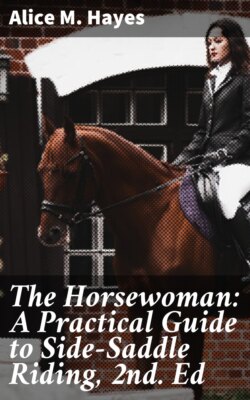Читать книгу The Horsewoman: A Practical Guide to Side-Saddle Riding, 2nd. Ed - Alice M. Hayes - Страница 39
На сайте Литреса книга снята с продажи.
ADJUSTMENT OF THE BRIDLE.
ОглавлениеTable of Contents
The bit is placed in the horse’s mouth, because there is a vacant space (of about four inches in length) on the gums of his lower jaw, between his back teeth and tushes (canine teeth or eye teeth), as we may see in Fig. 49. A mare has no tushes, or possesses them in only a rudimentary form. The tushes of a horse begin to appear through his gums when he is about 4 years old. If horses had not this convenient gap (interdental space) in their rows of teeth, we would probably have to guide and control them by means of reins attached to a nose-band, which is a method practised by many American cow-boys when breaking in young horses. Owing to the fact that their nose-band (hackamore) does not hurt the animal’s mouth, and that it gives all the necessary indications, excellent results, I believe, are obtained with it.
Fig. 51.—View of under-surface of Lower Jaw.
As the pressure of the bit should be an indication of the wishes of the rider and not a means of inflicting pain, the bit should rest on the least sensitive portion of the interdental space, namely, on the part just above the tushes; because there the jaw-bone is broader than higher up, and is consequently better able to bear pressure. Hence, with a double bridle, the mouth-piece of the curb should be just clear of the tushes of the horse or gelding (Fig. 49), and about one inch above the corner front teeth of the mare; in fact, as low as possible without making the curb-chain liable to slip over the animal’s chin. The fact of the mouth-piece of the curb being in this position has the further advantage, that it prevents the curb-chain from working up on the sharp edges of the lower surface of the jaw. The curb-chain in Fig. 50 rests in what is called the “chin-groove,” which is the depression that covers the bone immediately below the point at which the lower jaw divides into two branches (Fig. 51). The edges of these branches are sharp, but that portion of the bone which is between their point of separation and the front teeth, is smooth and rounded.
The snaffle, whether by itself or in conjunction with a curb, should be placed sufficiently low, so as not to wrinkle the corners of the mouth.
The tightness of the curb-chain should in no case exceed that which will allow the cheeks of the curb the amount of “play” shown in Fig. 50. With a light mouthed horse, the curb-chain might be let out another hole or two.
The throat-latch should be loose, so that it may not exert any pressure on the animal’s wind-pipe.
